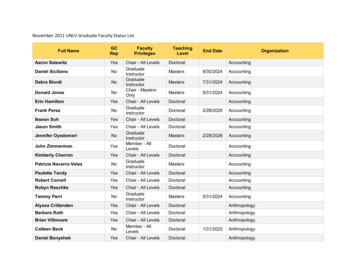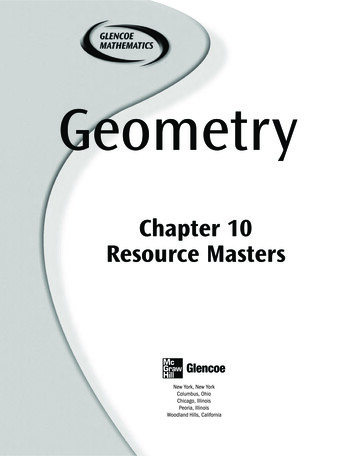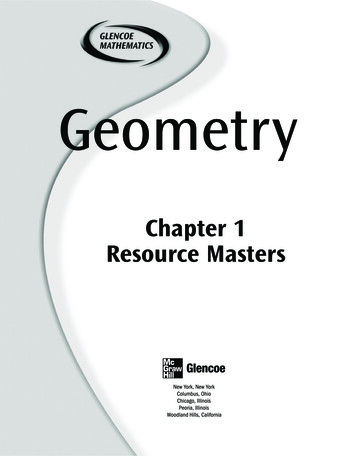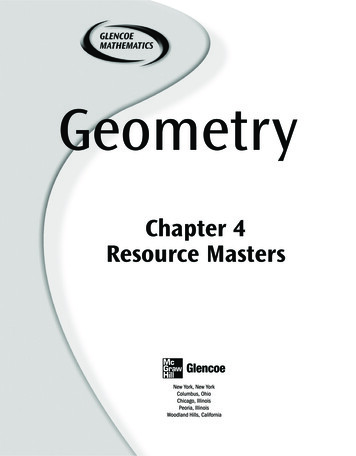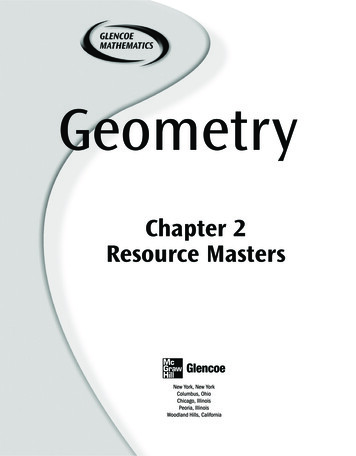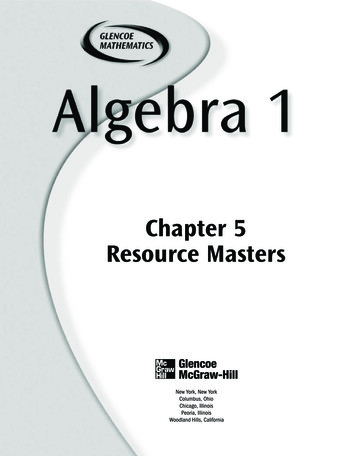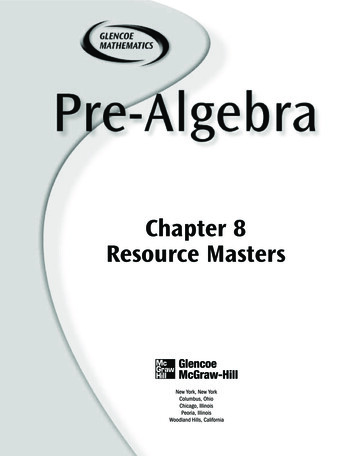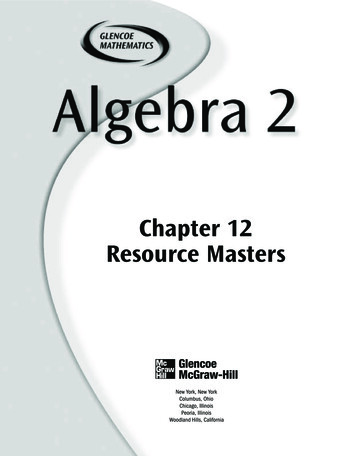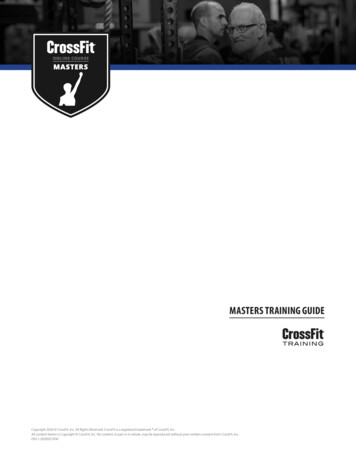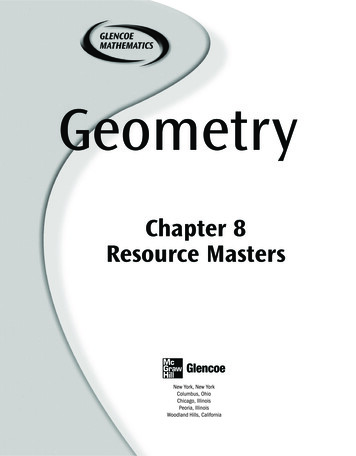
Transcription
GeometryChapter 8Resource Masters
Consumable WorkbooksMany of the worksheets contained in the Chapter Resource Masters bookletsare available as consumable workbooks.Study Guide and Intervention WorkbookSkills Practice WorkbookPractice WorkbookReading to Learn Mathematics 7-861061-3ANSWERS FOR WORKBOOKS The answers for Chapter 8 of these workbookscan be found in the back of this Chapter Resource Masters booklet.Copyright by The McGraw-Hill Companies, Inc. All rights reserved.Printed in the United States of America. Permission is granted to reproduce thematerial contained herein on the condition that such material be reproduced onlyfor classroom use; be provided to students, teachers, and families without charge;and be used solely in conjunction with Glencoe’s Geometry. Any other reproduction,for use or sale, is prohibited without prior written permission of the publisher.Send all inquiries to:The McGraw-Hill Companies8787 Orion PlaceColumbus, OH 43240-4027ISBN: 0-07-860185-11 2 3 4 5 6 7 8 9 10 009 11 10 09 08 07 06 05 04 03GeometryChapter 8 Resource Masters
ContentsVocabulary Builder . . . . . . . . . . . . . . . . viiLesson 8-6Proof Builder . . . . . . . . . . . . . . . . . . . . . . ixStudy Guide and Intervention . . . . . . . . 447–448Skills Practice . . . . . . . . . . . . . . . . . . . . . . . 449Practice . . . . . . . . . . . . . . . . . . . . . . . . . . . 450Reading to Learn Mathematics . . . . . . . . . . 451Enrichment . . . . . . . . . . . . . . . . . . . . . . . . . 452Lesson 8-1Study Guide and Intervention . . . . . . . . 417–418Skills Practice . . . . . . . . . . . . . . . . . . . . . . . 419Practice . . . . . . . . . . . . . . . . . . . . . . . . . . . 420Reading to Learn Mathematics . . . . . . . . . . 421Enrichment . . . . . . . . . . . . . . . . . . . . . . . . . 422Lesson 8-7Study Guide and Intervention . . . . . . . . 453–454Skills Practice . . . . . . . . . . . . . . . . . . . . . . . 455Practice . . . . . . . . . . . . . . . . . . . . . . . . . . . 456Reading to Learn Mathematics . . . . . . . . . . 457Enrichment . . . . . . . . . . . . . . . . . . . . . . . . . 458Lesson 8-2Study Guide and Intervention . . . . . . . . 423–424Skills Practice . . . . . . . . . . . . . . . . . . . . . . . 425Practice . . . . . . . . . . . . . . . . . . . . . . . . . . . 426Reading to Learn Mathematics . . . . . . . . . . 427Enrichment . . . . . . . . . . . . . . . . . . . . . . . . . 428Chapter 8 rLesson 8-3Study Guide and Intervention . . . . . . . . 429–430Skills Practice . . . . . . . . . . . . . . . . . . . . . . . 431Practice . . . . . . . . . . . . . . . . . . . . . . . . . . . 432Reading to Learn Mathematics . . . . . . . . . . 433Enrichment . . . . . . . . . . . . . . . . . . . . . . . . . 434Lesson 8-4Study Guide and Intervention . . . . . . . . 435–436Skills Practice . . . . . . . . . . . . . . . . . . . . . . . 437Practice . . . . . . . . . . . . . . . . . . . . . . . . . . . 438Reading to Learn Mathematics . . . . . . . . . . 439Enrichment . . . . . . . . . . . . . . . . . . . . . . . . . 440Standardized Test PracticeStudent Recording Sheet . . . . . . . . . . . . . . A1Lesson 8-5ANSWERS . . . . . . . . . . . . . . . . . . . . . . A2–A32Study Guide and Intervention . . . . . . . . 441–442Skills Practice . . . . . . . . . . . . . . . . . . . . . . . 443Practice . . . . . . . . . . . . . . . . . . . . . . . . . . . 444Reading to Learn Mathematics . . . . . . . . . . 445Enrichment . . . . . . . . . . . . . . . . . . . . . . . . . 446 Glencoe/McGraw-Hill8 Test, Form 1 . . . . . . . . . . . . 459–4608 Test, Form 2A . . . . . . . . . . . 461–4628 Test, Form 2B . . . . . . . . . . . 463–4648 Test, Form 2C . . . . . . . . . . . 465–4668 Test, Form 2D . . . . . . . . . . . 467–4688 Test, Form 3 . . . . . . . . . . . . 469–4708 Open-Ended Assessment . . . . . . 4718 Vocabulary Test/Review . . . . . . . 4728 Quizzes 1 & 2 . . . . . . . . . . . . . . . 4738 Quizzes 3 & 4 . . . . . . . . . . . . . . . 4748 Mid-Chapter Test . . . . . . . . . . . . 4758 Cumulative Review . . . . . . . . . . . 4768 Standardized Test Practice . 477–478iiiGlencoe Geometry
Teacher’s Guide to Using theChapter 8 Resource MastersThe Fast File Chapter Resource system allows you to conveniently file the resourcesyou use most often. The Chapter 8 Resource Masters includes the core materials neededfor Chapter 8. These materials include worksheets, extensions, and assessment options.The answers for these pages appear at the back of this booklet.All of the materials found in this booklet are included for viewing and printing in theGeometry TeacherWorks CD-ROM.Vocabulary BuilderPages vii–viiiinclude a student study tool that presentsup to twenty of the key vocabulary termsfrom the chapter. Students are to recorddefinitions and/or examples for each term.You may suggest that students highlight orstar the terms with which they are notfamiliar.Skills PracticeWHEN TO USE Give these pages toPractice There is one master for eachlesson. These problems more closely followthe structure of the Practice and Applysection of the Student Edition exercises.These exercises are of average difficulty.There is one master foreach lesson. These provide computationalpractice at a basic level.WHEN TO USE These masters can beused with students who have weakermathematics backgrounds or needadditional reinforcement.students before beginning Lesson 8-1.Encourage them to add these pages to theirGeometry Study Notebook. Remind them toadd definitions and examples as theycomplete each lesson.WHEN TO USE These provide additionalpractice options or may be used ashomework for second day teaching of thelesson.Vocabulary BuilderPages ix–xinclude another student study tool thatpresents up to fourteen of the key theoremsand postulates from the chapter. Studentsare to write each theorem or postulate intheir own words, including illustrations ifthey choose to do so. You may suggest thatstudents highlight or star the theorems orpostulates with which they are not familiar.Reading to Learn MathematicsOne master is included for each lesson. Thefirst section of each master asks questionsabout the opening paragraph of the lessonin the Student Edition. Additionalquestions ask students to interpret thecontext of and relationships among termsin the lesson. Finally, students are asked tosummarize what they have learned usingvarious representation techniques.WHEN TO USE Give these pages tostudents before beginning Lesson 8-1.Encourage them to add these pages to theirGeometry Study Notebook. Remind them toupdate it as they complete each lesson.WHEN TO USE This master can be usedas a study tool when presenting the lessonor as an informal reading assessment afterpresenting the lesson. It is also a helpfultool for ELL (English Language Learner)students.Study Guide and InterventionEach lesson in Geometry addresses twoobjectives. There is one Study Guide andIntervention master for each objective.WHEN TO USE Use these masters asreteaching activities for students who needadditional reinforcement. These pages canalso be used in conjunction with the StudentEdition as an instructional tool for studentswho have been absent. Glencoe/McGraw-HillivGlencoe Geometry
A Vocabulary Test, suitable for allstudents, includes a list of the vocabularywords in the chapter and ten questionsassessing students’ knowledge of thoseterms. This can also be used in conjunction with one of the chapter tests or as areview worksheet.EnrichmentThere is one extensionmaster for each lesson. These activities mayextend the concepts in the lesson, offer anhistorical or multicultural look at theconcepts, or widen students’ perspectives onthe mathematics they are learning. Theseare not written exclusively for honorsstudents, but are accessible for use with alllevels of students.Intermediate Assessment Four free-response quizzes are includedto offer assessment at appropriateintervals in the chapter.WHEN TO USE These may be used asextra credit, short-term projects, or asactivities for days when class periods areshortened. A Mid-Chapter Test provides an optionto assess the first half of the chapter. It iscomposed of both multiple-choice andfree-response questions.Assessment OptionsThe assessment masters in the Chapter 8Resources Masters offer a wide range ofassessment tools for intermediate and finalassessment. The following lists describe eachassessment master and its intended use.Continuing Assessment The Cumulative Review providesstudents an opportunity to reinforce andretain skills as they proceed throughtheir study of Geometry. It can also beused as a test. This master includesfree-response questions.Chapter AssessmentCHAPTER TESTS The Standardized Test Practice offerscontinuing review of geometry conceptsin various formats, which may appear onthe standardized tests that they mayencounter. This practice includes multiplechoice, grid-in, and short-responsequestions. Bubble-in and grid-in answersections are provided on the master. Form 1 contains multiple-choice questionsand is intended for use with basic levelstudents. Forms 2A and 2B contain multiple-choicequestions aimed at the average levelstudent. These tests are similar in formatto offer comparable testing situations. Forms 2C and 2D are composed of freeresponse questions aimed at the averagelevel student. These tests are similar informat to offer comparable testingsituations. Grids with axes are providedfor questions assessing graphing skills.Answers Page A1 is an answer sheet for theStandardized Test Practice questionsthat appear in the Student Edition onpages 458–459. This improves students’familiarity with the answer formats theymay encounter in test taking. Form 3 is an advanced level test withfree-response questions. Grids withoutaxes are provided for questions assessinggraphing skills. The answers for the lesson-by-lessonmasters are provided as reduced pageswith answers appearing in red.All of the above tests include a freeresponse Bonus question. Full-size answer keys are provided forthe assessment masters in this booklet. The Open-Ended Assessment includesperformance assessment tasks that aresuitable for all students. A scoring rubricis included for evaluation guidelines.Sample answers are provided forassessment. Glencoe/McGraw-HillvGlencoe Geometry
NAME DATEPERIODReading to Learn Mathematics8This is an alphabetical list of the key vocabulary terms you will learn in Chapter 8.As you study the chapter, complete each term’s definition or description. Rememberto add the page number where you found the term. Add these pages to yourGeometry Study Notebook to review vocabulary at the end of the chapter.Vocabulary TermFoundon es trapezoidkitemedian(continued on the next page) Glencoe/McGraw-HillviiGlencoe GeometryVocabulary BuilderVocabulary Builder
NAME DATEPERIODReading to Learn Mathematics8Vocabulary BuilderVocabulary Term(continued)Foundon tanglerhombussquaretrapezoid Glencoe/McGraw-HillviiiGlencoe Geometry
NAME DATE8PERIODLearning to Read MathematicsThis is a list of key theorems and postulates you will learn in Chapter 8. As youstudy the chapter, write each theorem or postulate in your own words. Includeillustrations as appropriate. Remember to include the page number where youfound the theorem or postulate. Add this page to your Geometry Study Notebookso you can review the theorems and postulates at the end of the chapter.Theorem or PostulateFoundon PageDescription/Illustration/AbbreviationTheorem 8.1Interior Angle Sum TheoremTheorem 8.2Exterior Angle Sum TheoremTheorem 8.3Theorem 8.4Theorem 8.5Theorem 8.7Theorem 8.8(continued on the next page) Glencoe/McGraw-HillixGlencoe GeometryProof BuilderProof Builder
NAME DATE8PERIODLearning to Read MathematicsProof BuilderTheorem or Postulate(continued)Foundon PageDescription/Illustration/AbbreviationTheorem 8.12Theorem 8.13Theorem 8.15Theorem 8.17Theorem 8.18Theorem 8.19Theorem 8.20 Glencoe/McGraw-HillxGlencoe Geometry
NAME DATE8-1PERIODStudy Guide and InterventionAngles of PolygonsSum of Measures of Interior AnglesThe segments that connect thenonconsecutive sides of a polygon are called diagonals. Drawing all of the diagonals fromone vertex of an n-gon separates the polygon into n ! 2 triangles. The sum of the measuresof the interior angles of the polygon can be found by adding the measures of the interiorangles of those n ! 2 triangles.Interior AngleSum TheoremExample 1A convex polygon has13 sides. Find the sum of the measuresof the interior angles.S " 180(n ! 2)" 180(13 ! 2)" 180(11)" 1980Example 2The measure of aninterior angle of a regular polygon is120. Find the number of sides.The number of sides is n, so the sum of themeasures of the interior angles is 120n.S " 180(n ! 2)120n " 180(n ! 2)120n " 180n ! 360!60n " !360n"6ExercisesFind the sum of the measures of the interior angles of each convex polygon.1. 10-gon2. 16-gon3. 30-gon4. 8-gon5. 12-gon6. 3x-gonThe measure of an interior angle of a regular polygon is given. Find the numberof sides in each polygon.7. 1508. 16010. 1659. 17511. 168.7513. Find x.12. 135D(4x " 5)!E 7x !(5x # 5)! C(6x " 10)!(4x " 10)!A Glencoe/McGraw-HillB417Glencoe GeometryLesson 8-1If a convex polygon has n sides, and S is the sum of the measures of its interior angles,then S " 180(n ! 2).
NAME DATE8-1PERIODStudy Guide and Intervention(continued)Angles of PolygonsSum of Measures of Exterior Anglesexterior angles of a convex polygon.Exterior AngleSum TheoremThere is a simple relationship among theIf a polygon is convex, then the sum of the measures of the exterior angles,one at each vertex, is 360.Example 1Find the sum of the measures of the exterior angles, one at eachvertex, of a convex 27-gon.For any convex polygon, the sum of the measures of its exterior angles, one at each vertex,is 360.Example 2Find the measure of each exterior angle ofregular hexagon ABCDEF.The sum of the measures of the exterior angles is 360 and a hexagonhas 6 angles. If n is the measure of each exterior angle, thenABCF6n " 360n " 60EDExercisesFind the sum of the measures of the exterior angles of each convex polygon.1. 10-gon2. 16-gon3. 36-gonFind the measure of an exterior angle for each convex regular polygon.4. 12-gon5. 36-gon6. 2x-gonFind the measure of an exterior angle given the number of sides of a regularpolygon.7. 408. 1810. 2411. 180 Glencoe/McGraw-Hill9. 1212. 8418Glencoe Geometry
NAME DATEPERIODSkills Practice8-1Angles of PolygonsFind the sum of the measures of the interior angles of each convex polygon.1. nonagon2. heptagon3. decagonThe measure of an interior angle of a regular polygon is given. Find the numberof sides in each polygon.5. 1206. 150Lesson 8-14. 108Find the measure of each interior angle using the given information.7.Ax!(2x # 15)!8. L(2B(2x # 15)!x!DCP9. quadrilateral STUW with !S ! !T,!U ! !W, m!S " 2x # 16,m!U " x # 14Sx " 20)! (3x # 10)!(2x # 10)!2x !N10. hexagon DEFGHI with!D ! !E ! !G ! !H, !F ! !I,m!D " 7x, m!F " 4xTDEIWMUFHGFind the measures of an interior angle and an exterior angle for each regularpolygon.11. quadrilateral12. pentagon13. dodecagonFind the measures of an interior angle and an exterior angle given the number ofsides of each regular polygon. Round to the nearest tenth if necessary.14. 8 Glencoe/McGraw-Hill15. 916. 13419Glencoe Geometry
NAME DATEPERIODPractice8-1Angles of PolygonsFind the sum of the measures of the interior angles of each convex polygon.1. 11-gon2. 14-gon3. 17-gonThe measure of an interior angle of a regular polygon is given. Find the numberof sides in each polygon.4. 1445. 1566. 160Find the measure of each interior angle using the given information.7.JN(2x " 15)!(3x # 20)!(x " 15)!8. quadrilateral RSTU withm!R " 6x ! 4, m!S " 2x # 8Kx!SRMUTFind the measures of an interior angle and an exterior angle for each regularpolygon. Round to the nearest tenth if necessary.9. 16-gon10. 24-gon11. 30-gonFind the measures of an interior angle and an exterior angle given the number ofsides of each regular polygon. Round to the nearest tenth if necessary.12. 1413. 2214. 4015. CRYSTALLOGRAPHY Crystals are classified according to seven crystal systems. Thebasis of the classification is the shapes of the faces of the crystal. Turquoise belongs tothe triclinic system. Each of the six faces of turquoise is in the shape of a parallelogram.Find the sum of the measures of the interior angles of one such face. Glencoe/McGraw-Hill420Glencoe Geometry
NAME DATE8-1PERIODReading to Learn MathematicsAngles of PolygonsPre-ActivityHow does a scallop shell illustrate the angles of polygons?Read the introduction to Lesson 8-1 at the top of page 404 in your textbook. How many diagonals of the scallop shell shown in your textbook can bedrawn from vertex A?Reading the Lesson1. Write an expression that describes each of the following quantities for a regular n-gon. Ifthe expression applies to regular polygons only, write regular. If it applies to all convexpolygons, write all.a. the sum of the measures of the interior anglesb. the measure of each interior anglec. the sum of the measures of the exterior angles (one at each vertex)d. the measure of each exterior angle2. Give the measure of an interior angle and the measure of an exterior angle of each polygon.a. equilateral trianglec. squareb. regular hexagond. regular octagon3. Underline the correct word or phrase to form a true statement about regular polygons.a. As the number of sides increases, the sum of the measures of the interior angles(increases/decreases/stays the same).b. As the number of sides increases, the measure of each interior angle(increases/decreases/stays the same).c. As the number of sides increases, the sum of the measures of the exterior angles(increases/decreases/stays the same).d. As the number of sides increases, the measure of each exterior angle(increases/decreases/stays the same).e. If a regular polygon has more than four sides, each interior angle will be a(n)(acute/right/obtuse) angle, and each exterior angle will be a(n) (acute/right/obtuse) angle.Helping You Remember4. A good way to remember a new mathematical idea or formula is to relate it to somethingyou already know. How can you use your knowledge of the Angle Sum Theorem (for atriangle) to help you remember the Interior Angle Sum Theorem? Glencoe/McGraw-Hill421Glencoe GeometryLesson 8-1 How many diagonals can be drawn from one vertex of an n-gon? Explainyour reasoning.
NAME DATE8-1PERIODEnrichmentTangramsThe tangram puzzle is composed of sevenpieces that form a square, as shown at theright. This puzzle has been a popularamusement for Chinese students forhundreds and perhaps thousands of years.Make a careful tracing of the figure above. Cut out the pieces and rearrangethem to form each figure below. Record each answer by drawing lines withineach figure.1.2.3.4.5.6.7. Create a different figure using the seven tangram pieces. Trace the outline.Then challenge another student to solve the puzzle. Glencoe/McGraw-Hill422Glencoe Geometry
NAME DATEPERIODStudy Guide and Intervention8-2ParallelogramsSides and Angles of Parallelograms A quadrilateral withboth pairs of opposite sides parallel is a parallelogram. Here are fourimportant properties of parallelograms.PQSRIf PQRS is a parallelogram, then"QP"!S"R" and P"S" !Q"R"The opposite angles of aparallelogram are congruent.!P ! !R and !S ! !QThe consecutive angles of aparallelogram are supplementary.!P and !S are supplementary; !S and !R are supplementary;!R and !Q are supplementary; !Q and !P are supplementary.If a parallelogram has one rightangle, then it has four right angles.If m!P " 90, then m!Q " 90, m!R " 90, and m!S " 90.ExampleIf ABCD is a parallelogram, find a and b.AB"" and C"D" are opposite sides, so A"B"!C"D".2a " 34a " 172aA 8b !D112!34BC!A and !C are opposite angles, so !A ! !C.8b " 112b " 14ExercisesFind x and y in each parallelogram.1.2.3x !8y6x !4y !883.6x3y4.6x !125.60!55!5x !6.Glencoe/McGraw-Hill12x !2y30x2y ! 3y !15072x423Glencoe GeometryLesson 8-2The opposite sides of aparallelogram are congruent.
NAME DATEPERIODStudy Guide and Intervention8-2(continued)ParallelogramsDiagonals of Parallelograms Two important properties ofparallelograms deal with their diagonals.ABPDCIf ABCD is a parallelogram, then:The diagonals of a parallelogram bisect each other.AP " PC and DP " PBEach diagonal separates a parallelograminto two congruent triangles."ACD ! "CAB and "ADB ! "CBDExampleFind x and y in parallelogram ABCD.The diagonals bisect each other, so AE " CE and DE " BE.6x " 244y " 18x"4y " 4.5AB186xDE 244yCExercisesFind x and y in each parallelogram.1.2.4y3x1284.285.30!y103.2y60!4x4y !2x !123x !2y6.4xy173xComplete each statement about !ABCD.Justify your answer.7. !BAC !ADBEC8. D"E"!9. "ADC !10. A"D" Glencoe/McGraw-Hill424Glencoe Geometry
NAME DATE8-2PERIODSkills PracticeParallelogramsComplete each statement about !DEFG. Justify your answer.?EHG2. D"E"!?3. G"H"!?4. !DEF !?5. !EFG is supplementary to6. "DGE !F? .?ALGEBRA Use !WXYZ to find each measure or value.7. m!XYZ "9. m!WXY "2aWXA8. m!WZY "Z10. a "50!70!30YCOORDINATE GEOMETRY Find the coordinates of the intersection of thediagonals of parallelogram HJKL given each set of vertices.11. H(1, 1), J(2, 3), K(6, 3), L(5, 1)12. H(!1, 4), J(3, 3), K(3, !2), L(!1, !1)13. PROOF Write a paragraph proof of the theorem Consecutive angles in a parallelogramare supplementary.AD Glencoe/McGraw-Hill425BCGlencoe GeometryLesson 8-21. D"G" D
NAME DATE8-2PERIODPracticeParallelogramsComplete each statement about !LMNP. Justify your answer.1. L"Q"!MQ?P2. !LMN !?3. "LMP !?4. !NPL is supplementary to5. L"M"!LN? .?ALGEBRA Use !RSTU to find each measure or value.6. m!RST "7. m!STU "8. m!TUR "9. b "RS25!B30!4b # 123UTCOORDINATE GEOMETRY Find the coordinates of the intersection of thediagonals of parallelogram PRYZ given each set of vertices.10. P(2, 5), R(3, 3), Y(!2, !3), Z(!3, !1)11. P(2, 3), R(1, !2), Y(!5, !7), Z(!4, !2)12. PROOF Write a paragraph proof of the following.Given: #PRST and #PQVUProve: !V ! !SQPUVT13. CONSTRUCTION Mr. Rodriquez used the parallelogram at the right todesign a herringbone pattern for a paving stone. He will use the pavingstone for a sidewalk. If m!1 is 130, find m!2, m!3, and m!4. Glencoe/McGraw-Hill426RS1423Glencoe Geometry
NAME DATE8-2PERIODReading to Learn MathematicsParallelogramsPre-ActivityHow are parallelograms used to represent data?Read the introduction to Lesson 8-2 at the top of page 411 in your textbook. What is the name of the shape of the top surface of each wedge of cheese? Are the three polygons shown in the drawing similar polygons? Explain yourreasoning.Reading the Lesson1. Underline words or phrases that can complete the following sentences to make statementsthat are always true. (There may be more than one correct choice for some of the sentences.)a. Opposite sides of a parallelogram are (congruent/perpendicular/parallel).c. A diagonal of a parallelogram divides the parallelogram into two(acute/right/obtuse/congruent) triangles.d. Opposite angles of a parallelogram are (complementary/supplementary/congruent).e. The diagonals of a parallelogram (bisect each other/are perpendicular/are congruent).f. If a parallelogram has one right angle, then all of its other angles are(acute/right/obtuse) angles.2. Let ABCD be a parallelogram with AB BC and with no right angles.a. Sketch a parallelogram that matches the descriptionabove and draw diagonal B"D".In parts b–f, complete each sentence.b. A"B" and A"D" c. A"B"!and B"C"!d. !A !and !ABC !e. !ADB !CAD.because these two angles areangles formed by the two parallel linestransversalf. "ABD !Bandand the.Helping You Remember3. A good way to remember new theorems in geometry is to relate them to theorems youlearned earlier. Name a theorem about parallel lines that can be used to remember thetheorem that says, “If a parallelogram has one right angle, it has four right angles.” Glencoe/McGraw-Hill427Glencoe GeometryLesson 8-2b. Consecutive angles of a parallelogram are (complementary/supplementary/congruent).
NAME DATE8-2PERIODEnrichmentTessellationsA tessellation is a tiling pattern made of polygons. The pattern canbe extended so that the polygonal tiles cover the plane completely withno gaps. A checkerboard and a honeycomb pattern are examples oftessellations. Sometimes the same polygon can make more than onetessellation pattern. Both patterns below can be formed from anisosceles triangle.Draw a tessellation using each polygon.1.2.3.Draw two different tessellations using each polygon.4. Glencoe/McGraw-Hill5.428Glencoe Geometry
NAME DATEPERIODStudy Guide and Intervention8-3Tests for ParallelogramsConditions for a Parallelogram There are many ways toestablish that a quadrilateral is a parallelogram.ADIf:BECIf: D"C" and A"D" B"C",both pairs of opposite sides are parallel,"BA"both pairs of opposite sides are congruent,"BA"!D"C" and A"D"!B"C",both pairs of opposite angles are congruent,!ABC ! !ADC and !DAB ! !BCD,the diagonals bisect each other,"EA"!C"E" and D"E"!B"E",one pair of opposite sides is congruent and parallel,"BA"then: the figure is a parallelogram.then: ABCD is a parallelogram.Find x and y so that FGHJ is aFparallelogram.FGHJ is a parallelogram if the lengths of the oppositesides are equal.6x # 3 " 156x " 12x"24x ! 2y "4(2) ! 2y "8 ! 2y "!2y "y"6x " 3G4x # 2yJ215H222!63Lesson 8-3Example C"D" and A"B"!C"D", or A"D" B"C" and A"D" !B"C",ExercisesFind x and y so that each quadrilateral is a parallelogram.1.2.2x # 22y811x !123.25!5y !5.4.5x !186.(x " y)!2x !30!24! 55!5y !Glencoe/McGraw-Hill9x !45!6y6y !3x !429Glencoe Geometry
NAME DATE8-3PERIODStudy Guide and Intervention(continued)Tests for ParallelogramsParallelograms on the Coordinate PlaneOn the coordinate plane, the DistanceFormula and the Slope Formula can be used to test if a quadrilateral is a parallelogram.ExampleDetermine whether ABCD is a parallelogram.The vertices are A(!2, 3), B(3, 2), C(2, !1), and D(!3, 0).y2 ! y1%.Method 1: Use the Slope Formula, m " %x2 ! x13!03slope of A"D" " %% " %% " 31!2 ! (!3)2!31slope of A"B" " %% " !%%53 ! (!2)2 ! (!1)3slope of B"C" " %% " %% " 33!21!1 ! 01slope of C"D" " %% " !%%52 ! (!3)yABODCxOpposite sides have the same slope, so A"B" C"D" and A"D" B"C". Both pairs of opposite sidesare parallel, so ABCD is a parallelogram.Method 2: Use the Distance Formula, d " #"(x2 ! "x1) 2 #"( y2 !"y1) 2.AB " #"(!2 !"3)2 #"(3 ! "2)2 " #"25 # 1" or #26"CD " #"(2 ! ("!3))2 "# (!1"! 0)2 " #"25 # 1" or #26"AD " #"(!2 !"(!3))2"# (3"! 0)2 " #"1 # 9 or #10"BC " #"(3 ! 2")2 # ("2 ! (!"1))2 " #"1 # 9 or #10"Both pairs of opposite sides have the same length, so ABCD is a parallelogram.ExercisesDetermine whether a figure with the given vertices is a parallelogram. Use themethod indicated.1. A(0, 0), B(1, 3), C(5, 3), D(4, 0);Slope Formula2. D(!1, 1), E(2, 4), F(6, 4), G(3, 1);Slope Formula3. R(!1, 0), S(3, 0), T(2, !3), U(!3, !2);Distance Formula4. A(!3, 2), B(!1, 4), C(2, 1), D(0, !1);Distance and Slope Formulas5. S(!2, 4), T(!1, !1), U(3, !4), V(2, 1);Distance and Slope Formulas6. F(3, 3), G(1, 2), H(!3, 1), I(!1, 4);Midpoint Formula7. A parallelogram has vertices R(!2, !1), S(2, 1), and T(0, !3). Find all possiblecoordinates for the fourth vertex. Glencoe/McGraw-Hill430Glencoe Geometry
NAME DATEPERIODSkills Practice8-3Tests for ParallelogramsDetermine whether each quadrilateral is a parallelogram. Justify your answer.1.2.3.4.COORDINATE GEOMETRY Determine whether a figure with the given vertices is aparallelogram. Use the method indicated.5. P(0, 0), Q(3, 4), S(7, 4), Y(4, 0); Slope FormulaLesson 8-36. S(!2, 1), R(1, 3), T(2, 0), Z(!1, !2); Distance and Slope Formula7. W(2, 5), R(3, 3), Y(!2, !3), N(!3, 1); Midpoint FormulaALGEBRA Find x and y so that each quadrilateral is a parallelogram.8.9.2x # 82yy10.(4x # 35)!(y " 15)!11.x " 20y " 203y " 2(2y # 5)! 113x " 162y ##4xy " 193x3"(3x " 10)!Glencoe/McGraw-Hill3x # 14431Glencoe Geometry
NAME DATEPERIODPractice8-3Tests for ParallelogramsDetermine whether each quadrilateral is a parallelogram. Justify your answer.1.2.3.118!4.62!62!118!COORDINATE GEOMETRY Determine whether a figure with the given vertices is aparallelogram. Use the method indicated.5. P(!5, 1), S(!2, 2), F(!1, !3), T(2, !2); Slope Formula6. R(!2, 5), O(1, 3), M(!3, !4), Y(!6, !2); Distance and Slope FormulaALGEBRA Find x and y so that each quadrilateral is a parallelogram.7.(5x " 29)!(3y " 15)!9.(5y # 9)!(7x # 11)!10.#6x7y " 38.12y # 7#4x#82y "2#3x"5#43y#2x"y"#4x " 6623#2#4yx"1211. TILE DESIGN The pattern shown in the figure is to consist of congruentparallelograms. How can the designer be certain that the shapes areparallelograms? Glencoe/McGraw-Hill432Glencoe Geometry
NAME
Glencoe/McGraw-Hill iv Glencoe Geometry Teacher’s Guide to Using the Chapter 8 Resource Masters The Fast File Chapter Resource system allows you to conveniently file the resources you use most often. The Chapter 8 Resource Masters includes the core materials needed for Chapter 8. These material

